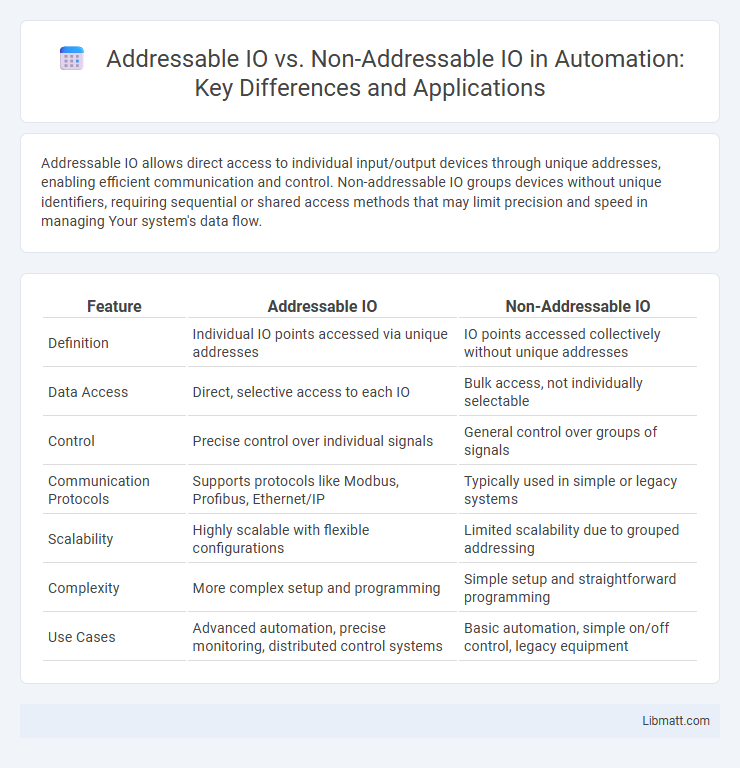Addressable IO allows direct access to individual input/output devices through unique addresses, enabling efficient communication and control. Non-addressable IO groups devices without unique identifiers, requiring sequential or shared access methods that may limit precision and speed in managing Your system's data flow.
Table of Comparison
| Feature | Addressable IO | Non-Addressable IO |
|---|---|---|
| Definition | Individual IO points accessed via unique addresses | IO points accessed collectively without unique addresses |
| Data Access | Direct, selective access to each IO | Bulk access, not individually selectable |
| Control | Precise control over individual signals | General control over groups of signals |
| Communication Protocols | Supports protocols like Modbus, Profibus, Ethernet/IP | Typically used in simple or legacy systems |
| Scalability | Highly scalable with flexible configurations | Limited scalability due to grouped addressing |
| Complexity | More complex setup and programming | Simple setup and straightforward programming |
| Use Cases | Advanced automation, precise monitoring, distributed control systems | Basic automation, simple on/off control, legacy equipment |
Understanding Addressable IO: Definition and Basics
Addressable IO refers to input/output operations where each device or data point is assigned a unique address, enabling precise communication and control within a system. This method allows the processor to directly access specific hardware components or memory locations by addressing them individually, enhancing data transfer efficiency. Addressable IO contrasts with non-addressable IO, which relies on shared channels or buses without unique identifiers for each device, often requiring polling or interrupts to manage data flow.
What is Non-Addressable IO? Key Concepts Explained
Non-Addressable IO refers to input/output operations where devices lack unique memory addresses, requiring communication through shared control lines or data buses instead of direct addressing. This concept is critical in systems where multiple peripherals send or receive data without individual address identification, often leading to increased complexity in device selection and data management. Understanding Non-Addressable IO helps you design efficient interfaces in embedded systems or legacy hardware environments where direct device addressing is not feasible.
Core Differences Between Addressable and Non-Addressable IO
Addressable IO allows direct access to specific input/output devices using unique addresses, enabling precise control and efficient data handling in embedded systems and microcontrollers. Non-addressable IO lacks this direct mapping, operating through shared or fixed communication ports, which can limit flexibility and increase the complexity of device management. Understanding these core differences helps optimize Your hardware design for speed, scalability, and resource allocation.
Advantages of Addressable IO in Modern Systems
Addressable IO enables direct access to specific memory locations or devices, resulting in faster data retrieval and improved system efficiency. It supports scalable and flexible architectures by allowing multiple input/output devices to be managed independently without complex decoding logic. In modern systems, this enhances multitasking capabilities and optimizes resource allocation, leading to better overall performance.
Limitations and Drawbacks of Non-Addressable IO
Non-addressable I/O systems face significant limitations due to their inability to directly target specific devices or memory locations, leading to increased processing overhead and slower data transfer rates. This lack of direct access causes inefficiencies in managing multiple peripherals, often resulting in higher CPU intervention and reduced system performance. Additionally, non-addressable I/O restricts scalability and flexibility in modern computing environments where precise device control is crucial.
Use Cases: When to Choose Addressable IO
Addressable IO is ideal for complex systems requiring precise control over multiple input/output devices, such as industrial automation, robotics, and embedded systems, where each device must be individually managed and monitored. Your choice should lean toward Addressable IO when scalability, efficient addressing of numerous sensors or actuators, and real-time data handling are critical to application performance. Non-addressable IO suits simpler scenarios with limited devices, but Addressable IO enables structured, flexible communication necessary for advanced control and diagnostics.
Common Applications of Non-Addressable IO
Non-addressable IO is commonly used in simple input devices like switches, LEDs, and basic control panels where precise memory mapping is unnecessary. Your system benefits from non-addressable IO in applications requiring direct hardware control without complex data interpretation, such as emergency stop buttons or status indicators. This form of IO enhances reliability and speed in embedded systems where straightforward signal handling is crucial.
Addressable IO vs Non-Addressable IO: Performance Comparison
Addressable IO systems enable direct access to individual input/output devices, leading to faster data transfer rates and reduced latency compared to non-addressable IO, which relies on sequential or polling methods. The performance advantage of addressable IO is evident in real-time applications where immediate device communication is critical, as it minimizes CPU overhead and improves system responsiveness. Conversely, non-addressable IO often incurs higher processing delays due to continuous scanning and less efficient device management.
Industry Trends: Shifts Toward Addressable IO
Industry trends reveal a growing preference for addressable I/O systems in automation and control applications due to their enhanced scalability and precise device identification. Addressable I/O enables streamlined troubleshooting and remote configuration, leading to reduced downtime and maintenance costs. As smart manufacturing and IoT integration expand, companies increasingly adopt addressable I/O for improved data analytics and system interoperability.
Choosing the Right IO for Your Project: Key Considerations
Choosing the right IO for your project depends on factors such as scalability, control precision, and cost efficiency. Addressable IO allows individual control over each device or signal, making it ideal for complex applications requiring detailed monitoring and customization. Non-addressable IO is simpler and often more cost-effective for basic tasks where grouped control suffices, so evaluating your project's complexity and control requirements ensures optimal performance and budget management.
Addressable IO vs Non-Addressable IO Infographic

 libmatt.com
libmatt.com